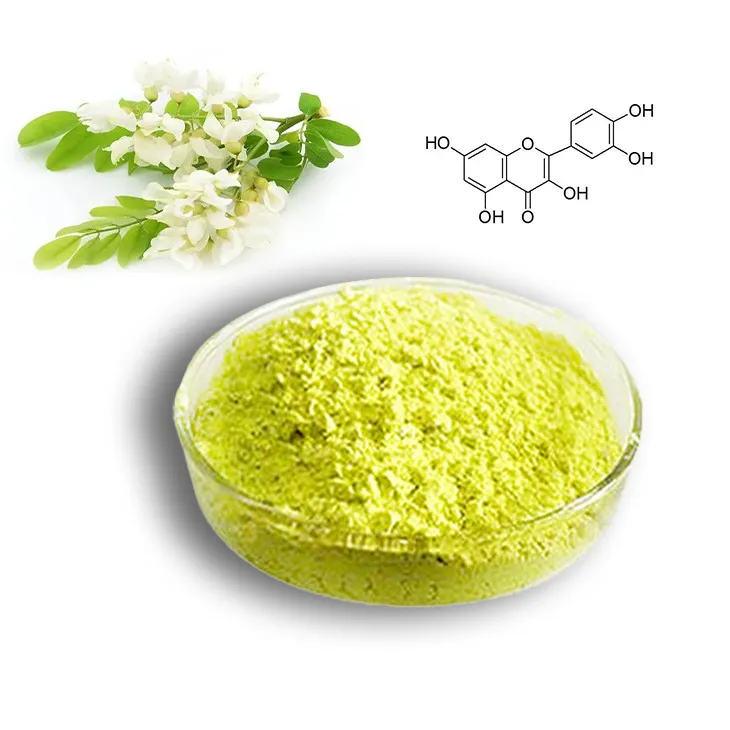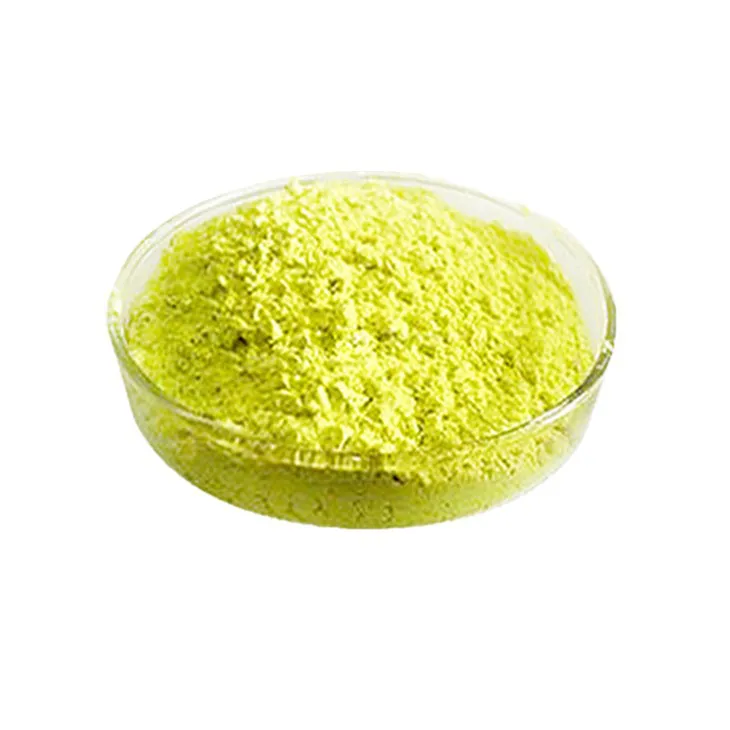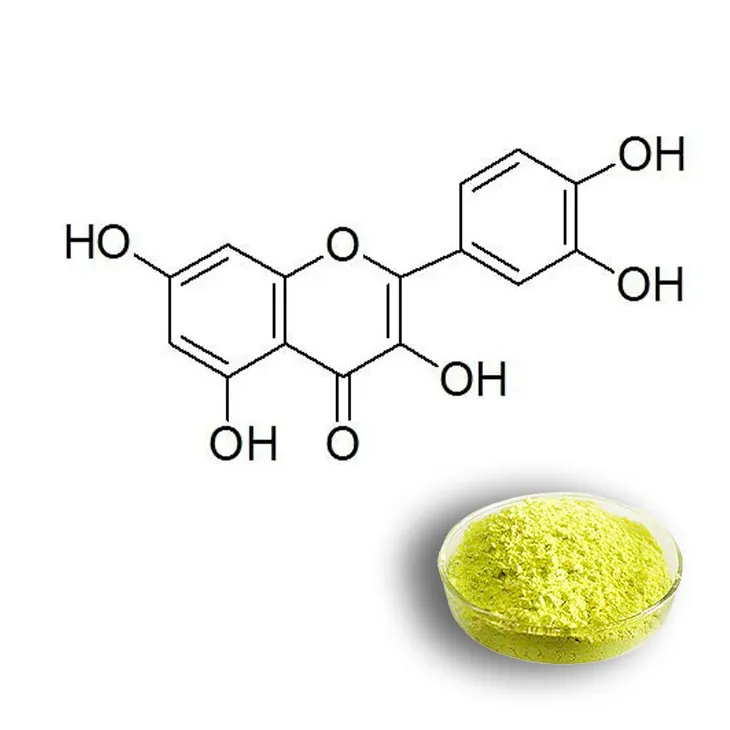- 0086-571-85302990
- sales@greenskybio.com
The process of extracting rutin quercetin - 3 - O - glucoside from rutin.
2024-11-29

1. Introduction
Rutin, a flavonol glycoside, is widely distributed in various plants. Quercetin - 3 - O - Glucoside, one of its derivatives, has shown great potential in the pharmaceutical and nutraceutical industries. The extraction process from rutin to Quercetin - 3 - O - Glucoside is of great significance due to the valuable properties of the final product.

2. Preparation of Rutin - rich Materials
2.1 Source Selection
Many plants are rich in rutin. Sophora japonica, for example, is a well - known plant source. The selection of the plant source depends on various factors such as the rutin content, availability, and cost. Some plants may have a higher rutin content in specific parts like leaves or flowers. For instance, the buckwheat plant contains a significant amount of rutin in its hulls.2.2 Pretreatment
Once the plant material is selected, it needs to be pretreated. This may involve drying the plant material to reduce moisture content. Drying can be carried out using different methods such as air - drying, oven - drying, or freeze - drying. Air - drying is a simple and cost - effective method, but it may take longer. Oven - drying can be faster but requires careful control of temperature to avoid degradation of rutin. Freeze - drying is a more advanced method that can better preserve the chemical structure of rutin but is relatively expensive. After drying, the plant material may need to be ground into a fine powder. Grinding helps to increase the surface area, which is beneficial for the subsequent extraction process. The powder should be of a uniform size to ensure consistent extraction results.
3. Extraction Solvents and Their Efficiencies
3.1 Ethanol
Ethanol is one of the most commonly used solvents for rutin extraction. It has several advantages. It is relatively safe, easily available, and has a good solubility for rutin. Ethanol - based extraction can be carried out at different concentrations. A higher concentration of ethanol may lead to a higher extraction yield, but it may also extract other unwanted compounds. For example, in some studies, 70% ethanol has been found to be an effective concentration for rutin extraction. The extraction process using ethanol usually involves soaking the rutin - rich powder in the ethanol solution for a certain period of time, followed by filtration to obtain the extract containing rutin.3.2 Methanol
Methanol is also a widely used solvent. It has a stronger solubilizing ability compared to ethanol for some flavonoids. However, methanol is more toxic, which requires more careful handling during the extraction process. Methanol - based extraction can be carried out in a similar way as ethanol extraction. But due to its toxicity, special safety measures need to be taken in the laboratory or industrial settings.3.3 Water
Water can be used as a solvent for rutin extraction, especially in the case of "green extraction" where the use of organic solvents is minimized. Although water has a lower solubility for rutin compared to ethanol and methanol, it can still extract a certain amount of rutin under appropriate conditions. For example, by using high - temperature and high - pressure extraction methods, the solubility of rutin in water can be increased. However, water - based extraction may also extract more impurities compared to organic solvent - based extraction.
4. Isolation and Purification of Quercetin - 3 - O - Glucoside
4.1 Chromatographic Methods
Chromatography is a powerful tool for the isolation and purification of quercetin - 3 - O - Glucoside. High - Performance Liquid Chromatography (HPLC) is one of the most commonly used methods. In HPLC, the extract containing rutin and other compounds is injected into a column filled with a stationary phase. The mobile phase, which is a solvent or a mixture of solvents, is then pumped through the column at a certain flow rate. Different compounds in the extract will have different affinities for the stationary and mobile phases, and thus will be separated as they move through the column. Quercetin - 3 - O - Glucoside can be collected at the appropriate time based on its retention time in the HPLC system. Another chromatographic method is Column Chromatography. It is a more traditional method compared to HPLC. In column chromatography, a glass or plastic column is filled with a stationary phase such as silica gel or alumina. The extract is then loaded onto the top of the column, and different solvents are used to elute the compounds. Quercetin - 3 - O - Glucoside can be isolated by carefully selecting the appropriate elution solvents and collecting the fractions containing the target compound.4.2 Precipitation
Precipitation can also be used for the isolation of quercetin - 3 - O - Glucoside. By adjusting the pH or adding certain reagents, quercetin - 3 - O - Glucoside can be made to precipitate out of the solution. For example, by adjusting the pH to an acidic range, some flavonoids may become less soluble and start to precipitate. However, this method may not be as precise as chromatographic methods and may require further purification steps.
5. Potential Applications in the Pharmaceutical and Nutraceutical Industries
5.1 Pharmaceutical Applications
Quercetin - 3 - O - Glucoside has shown potential in various pharmaceutical applications. It has antioxidant properties, which can help to protect cells from oxidative damage. Oxidative stress is associated with many diseases such as cancer, cardiovascular diseases, and neurodegenerative diseases. By scavenging free radicals, quercetin - 3 - O - Glucoside may play a role in preventing or treating these diseases. In addition, it has anti - inflammatory properties. Inflammation is a key factor in many chronic diseases. Quercetin - 3 - O - Glucoside can inhibit the production of inflammatory mediators, thus reducing inflammation. It may also have potential in the treatment of allergic diseases as it can modulate the immune response.5.2 Nutraceutical Applications
In the nutraceutical industry, quercetin - 3 - O - Glucoside can be used as a dietary supplement. It can be added to functional foods or beverages. Due to its antioxidant and anti - inflammatory properties, it can provide health benefits to consumers. For example, it may improve cardiovascular health by reducing blood lipid levels and improving blood vessel function. It may also enhance the immune system and help to prevent age - related diseases.6. Conclusion
The extraction of quercetin - 3 - O - Glucoside from rutin is a complex process that involves multiple steps from the preparation of rutin - rich materials to the isolation and purification of the final product. Different extraction solvents have different efficiencies, and chromatographic methods are powerful tools for isolation and purification. The potential applications of quercetin - 3 - O - Glucoside in the pharmaceutical and nutraceutical industries make this extraction process worthy of further study and development.
FAQ:
What are the common sources of Rutin - rich materials?
Common sources of Rutin - rich materials include various plants such as buckwheat, sophora japonica, and citrus fruits. These plants naturally contain significant amounts of rutin, which can be used as the starting material for the extraction of Quercetin - 3 - O - Glucoside.
Which solvents are commonly used for the extraction of Quercetin - 3 - O - Glucoside from Rutin?
Ethanol is one of the most commonly used solvents for this extraction. It has a relatively good solubility for rutin and can effectively extract the compound. Additionally, methanol can also be used. However, the choice of solvent may also depend on factors such as cost, safety, and environmental impact.
What are the key factors affecting the efficiency of the extraction process?
The key factors include the type of solvent used, as different solvents have different solubilities for rutin and Quercetin - 3 - O - Glucoside. The extraction time also plays a role. Longer extraction times may lead to higher yields, but there may also be a risk of degrading the compounds. Temperature is another factor. Higher temperatures can sometimes increase the solubility and extraction rate, but excessive heat may damage the target compounds.
How is Quercetin - 3 - O - Glucoside isolated and purified after extraction?
After extraction, techniques such as chromatography can be used for isolation and purification. Column chromatography, for example, can separate Quercetin - 3 - O - Glucoside from other impurities based on differences in their chemical properties such as polarity. Recrystallization can also be an effective method to further purify the compound.
What are the potential pharmaceutical applications of Quercetin - 3 - O - Glucoside?
Quercetin - 3 - O - Glucoside has potential antioxidant properties. It may be used in the development of drugs for treating oxidative stress - related diseases. It also has anti - inflammatory effects and could potentially be used in the treatment of inflammatory disorders. Additionally, it may have potential in the area of cardiovascular health, for example, by helping to regulate blood pressure or lipid levels.
Related literature
- Extraction and Characterization of Rutin and Quercetin - 3 - O - Glucoside from Plant Sources"
- "Optimization of the Extraction Process of Quercetin - 3 - O - Glucoside from Rutin - rich Plants"
- "The Role of Quercetin - 3 - O - Glucoside in Pharmaceutical and Nutraceutical Applications"
- ▶ Hesperidin
- ▶ citrus bioflavonoids
- ▶ plant extract
- ▶ lycopene
- ▶ Diosmin
- ▶ Grape seed extract
- ▶ Sea buckthorn Juice Powder
- ▶ Beetroot powder
- ▶ Hops Extract
- ▶ Artichoke Extract
- ▶ Reishi mushroom extract
- ▶ Astaxanthin
- ▶ Green Tea Extract
- ▶ Curcumin Extract
- ▶ Horse Chestnut Extract
- ▶ Other Problems
- ▶ Boswellia Serrata Extract
- ▶ Resveratrol Extract
- ▶ Marigold Extract
- ▶ Grape Leaf Extract
- ▶ blog3
- ▶ blog4
-
Ginseng root extract manufacturers.
2024-11-29
-
Organic Olive Leaf Extract, Australia.
2024-11-29
-
The best organic green tea extract.
2024-11-29
-
Ashwagandha extract manufacturer.
2024-11-29
-
High - quality peppermint oil products.
2024-11-29
-
Black Garlic Extract
2024-11-29
-
Mango flavored powder
2024-11-29
-
Bitter Melon Extract
2024-11-29
-
Saponin Extract
2024-11-29
-
Lotus leaf extract
2024-11-29
-
Hericium erinaceus extract powder
2024-11-29
-
Passionflower Extract
2024-11-29
-
Grapefruit Seed Extract Powder
2024-11-29
-
Moringa powder
2024-11-29
-
Polygonum Cuspidatum Extract
2024-11-29





















